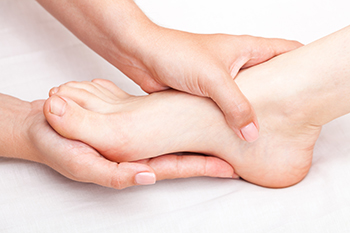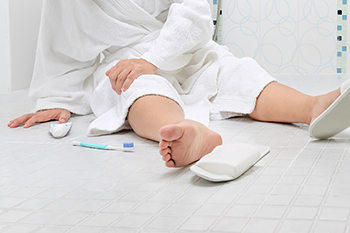Items filtered by date: September 2023
Understanding the Causes of Tarsal Tunnel Syndrome

Tarsal tunnel syndrome, abbreviated TTS, is a relatively lesser-known but impactful condition affecting the feet. It is comparable to the more recognized carpal tunnel syndrome but occurs in the ankle. TTS is characterized by compression or irritation of the tibial nerve as it passes through the tarsal tunnel, a narrow space on the inside of the ankle, behind the medial malleolus. Various factors can contribute to TTS, with the most common cause being excessive pressure on the nerve due to inflammation or injury. Additional potential causes include overpronation, diabetes, and systemic diseases such as arthritis. Symptoms often include tingling, burning sensations, and pain along the inner ankle and sole that can radiate into the toes. Treatment options for tarsal tunnel syndrome depend on its severity. Conservative approaches include getting adequate rest, taking anti-inflammatory medications, or wearing orthotic devices. These treatments can help to alleviate pressure on the nerve. In severe cases, surgical intervention may be necessary to decompress the tibial nerve. Early diagnosis and appropriate management are essential to relieving the discomfort associated with tarsal tunnel syndrome and restoring normal foot function. If you have this condition, it is strongly suggested that you are under the care of a podiatrist who can effectively manage tarsal tunnel syndrome.
Tarsal tunnel syndrome can be very uncomfortable to live with. If you are experiencing tarsal tunnel syndrome, contact Kenneth Williams, DPM of Texas. Our doctor can provide the care you need to keep you pain-free and on your feet.
Tarsal Tunnel Syndrome
Tarsal tunnel syndrome, which can also be called tibial nerve dysfunction, is an uncommon condition of misfiring peripheral nerves in the foot. The tibial nerve is the peripheral nerve in the leg responsible for sensation and movement of the foot and calf muscles. In tarsal tunnel syndrome, the tibial nerve is damaged, causing problems with movement and feeling in the foot of the affected leg.
Common Cause of Tarsal Tunnel Syndrome
- Involves pressure or an injury, direct pressure on the tibial nerve for an extended period of time, sometimes caused by other body structures close by or near the knee.
- Diseases that damage nerves, including diabetes, may cause tarsal tunnel syndrome.
- At times, tarsal tunnel syndrome can appear without an obvious cause in some cases.
The Effects of Tarsal Tunnel Syndrome
- Different sensations, an afflicted person may experience pain, tingling, burning or other unusual sensations in the foot of the affected leg.
- The foot muscles, toes and ankle become weaker, and curling your toes or flexing your foot can become difficult.
- If condition worsens, infections and ulcers may develop on the foot that is experiencing the syndrome.
A physical exam of the leg can help identify the presence of tarsal tunnel syndrome. Medical tests, such as a nerve biopsy, are also used to diagnose the condition. Patients may receive physical therapy and prescriptive medication. In extreme cases, some may require surgery.
If you have any questions please feel free to contact our office located in San Antonio and Beeville, TX . We offer the newest diagnostic and treatment technologies for all your foot and ankle needs.
A Simple Daily Foot Care Routine for Healthy Feet

Our feet bear the weight of our daily activities, often without getting the attention they truly deserve. Incorporating an everyday foot care routine into your daily life can help keep your feet healthy. This can begin by cleansing your feet daily with mild soap and warm water, ensuring they are thoroughly dried, and paying special attention to the spaces between your toes. Moisturizing your feet with a hydrating lotion can help to prevent dryness and cracking, and trimming your toenails straight across is necessary to avoid ingrown nails. Wearing comfortable, well-fitting shoes that have adequate arch support is crucial in maintaining foot health. Additionally, it is beneficial to rest your feet by taking short breaks to stretch and wiggle your toes during the day. Lastly, inspect your feet regularly for any signs of blisters, calluses, or changes in color or texture. By incorporating these simple habits into your daily routine, you can enjoy healthy feet that support you throughout your life. If you would like more information about other foot care tips, it is suggested that you confer with a podiatrist who can provide you with the knowledge you are seeking.
Everyday foot care is very important to prevent infection and other foot ailments. If you need your feet checked, contact Kenneth Williams, DPM from Texas. Our doctor can provide the care you need to keep you pain-free and on your feet.
Everyday Foot Care
Often, people take care of their bodies, face and hair more so than they do for their feet. But the feet are a very important aspect of our bodies, and one that we should pay more attention to. Without our feet, we would not be able to perform most daily tasks.
It is best to check your feet regularly to make sure there are no new bruises or cuts that you may not have noticed before. For dry feet, moisturizer can easily be a remedy and can be applied as often as necessary to the affected areas. Wearing shoes that fit well can also help you maintain good foot health, as well as making it easier to walk and do daily activities without the stress or pain of ill-fitting shoes, high heels, or even flip flops. Wearing clean socks with closed shoes is important to ensure that sweat and bacteria do not accumulate within the shoe. Clean socks help to prevent Athlete’s foot, fungi problems, bad odors, and can absorb sweat.
If you have any questions please feel free to contact our office located in San Antonio and Beeville, TX . We offer the newest diagnostic and treatment technologies for all your foot and ankle needs.
Identifying Risk Factors for Falling

Falls, often underestimated, can have serious consequences, especially as we age. Recognizing the risk factors that contribute to falls is the first step in ensuring our safety and well-being. These factors encompass a range of physical, environmental, and lifestyle elements. Physical factors can include muscle weakness, impaired balance, and diminished vision. Environmental hazards such as walking on uneven surfaces, poor lighting, and clutter can further increase the risk. Fortunately, taking proactive measures can significantly lower these risks. These can consist of engaging in regular physical activity to enhance muscle strength and balance, and ensuring proper lighting. Additionally, maintaining a clutter-free living space, and consulting healthcare professionals to manage health conditions are crucial strategies. It is suggested that you confer with a podiatrist who can discuss with you how falling can affect the feet, in addition to effective fall prevention strategies.
Preventing falls among the elderly is very important. If you are older and have fallen or fear that you are prone to falling, consult with Kenneth Williams, DPM from Texas. Our doctor will assess your condition and provide you with quality advice and care.
Every 11 seconds, an elderly American is being treated in an emergency room for a fall related injury. Falls are the leading cause of head and hip injuries for those 65 and older. Due to decreases in strength, balance, senses, and lack of awareness, elderly persons are very susceptible to falling. Thankfully, there are a number of things older persons can do to prevent falls.
How to Prevent Falls
Some effective methods that older persons can do to prevent falls include:
- Enrolling in strength and balance exercise program to increase balance and strength
- Periodically having your sight and hearing checked
- Discuss any medications you have with a doctor to see if it increases the risk of falling
- Clearing the house of falling hazards and installing devices like grab bars and railings
- Utilizing a walker or cane
- Wearing shoes that provide good support and cushioning
- Talking to family members about falling and increasing awareness
Falling can be a traumatic and embarrassing experience for elderly persons; this can make them less willing to leave the house, and less willing to talk to someone about their fears of falling. Doing such things, however, will increase the likelihood of tripping or losing one’s balance. Knowing the causes of falling and how to prevent them is the best way to mitigate the risk of serious injury.
If you have any questions, please feel free to contact our office located in San Antonio and Beeville, TX . We offer the newest diagnostic and treatment technologies for all your foot care needs.
